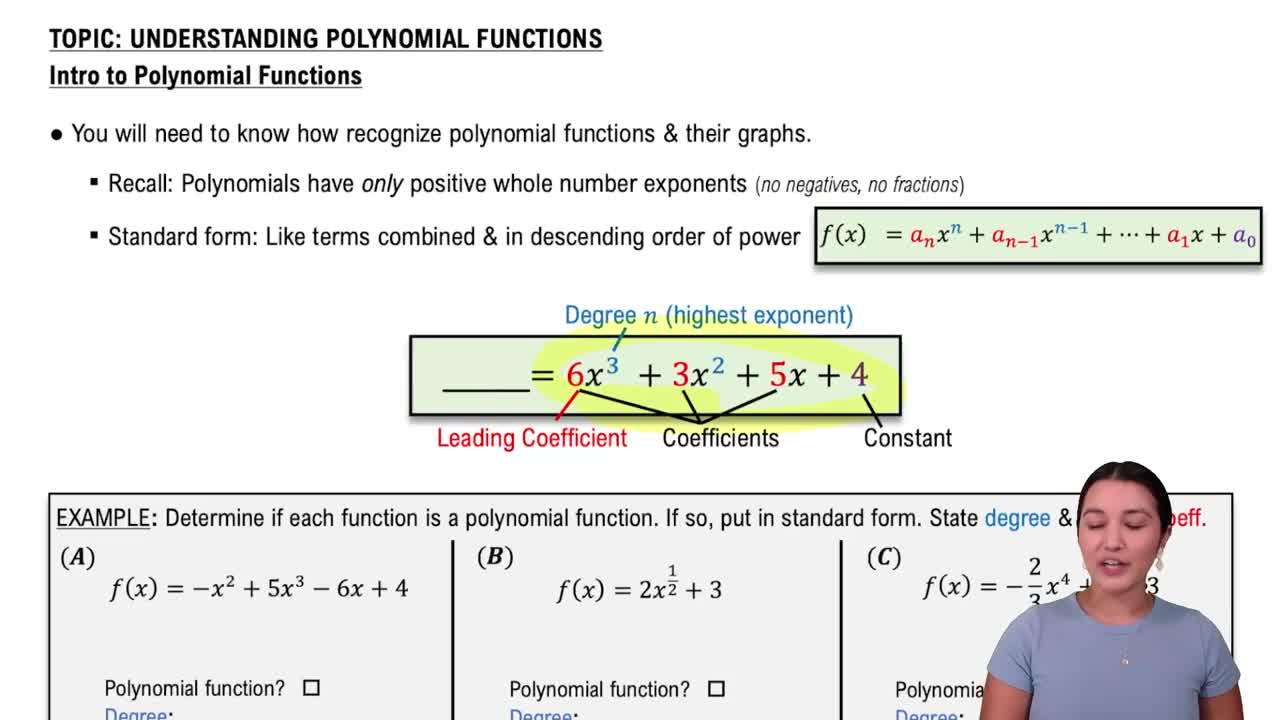Table of contents
- 0. Review of Algebra4h 16m
- 1. Equations & Inequalities3h 18m
- 2. Graphs of Equations43m
- 3. Functions2h 17m
- 4. Polynomial Functions1h 44m
- 5. Rational Functions1h 23m
- 6. Exponential & Logarithmic Functions2h 28m
- 7. Systems of Equations & Matrices4h 6m
- 8. Conic Sections2h 23m
- 9. Sequences, Series, & Induction1h 19m
- 10. Combinatorics & Probability1h 45m
3. Functions
Function Operations
Problem 35b
Textbook Question
In Exercises 31–50, find ƒ+g and determine the domain for each function. f(x) = 2x² − x − 3, g (x) = x + 1
 Verified step by step guidance
Verified step by step guidance1
Step 1: Understand the problem. We need to find the sum of two functions, \( f(x) = 2x^2 - x - 3 \) and \( g(x) = x + 1 \), which is denoted as \( (f+g)(x) \).
Step 2: Add the functions. To find \( (f+g)(x) \), add \( f(x) \) and \( g(x) \) together: \( (f+g)(x) = f(x) + g(x) = (2x^2 - x - 3) + (x + 1) \).
Step 3: Combine like terms. Simplify the expression by combining like terms: \( 2x^2 - x + x - 3 + 1 \).
Step 4: Simplify the expression. Combine the terms to get \( 2x^2 - 2 \).
Step 5: Determine the domain. Since both \( f(x) \) and \( g(x) \) are polynomials, their domain is all real numbers. Therefore, the domain of \( (f+g)(x) \) is also all real numbers.
Recommended similar problem, with video answer:
 Verified Solution
Verified SolutionThis video solution was recommended by our tutors as helpful for the problem above
Video duration:
3mPlay a video:
Was this helpful?
Key Concepts
Here are the essential concepts you must grasp in order to answer the question correctly.
Function Addition
Function addition involves combining two functions by adding their outputs for each input. For functions f(x) and g(x), the sum is defined as (f + g)(x) = f(x) + g(x). This operation requires evaluating both functions at the same x-value and summing the results, which is essential for solving the given problem.
Recommended video:

Adding & Subtracting Functions Example 1
Domain of a Function
The domain of a function is the set of all possible input values (x-values) for which the function is defined. For polynomial functions like f(x) = 2x² − x − 3 and g(x) = x + 1, the domain is typically all real numbers, unless specified otherwise by restrictions such as division by zero or square roots of negative numbers.
Recommended video:

Domain Restrictions of Composed Functions
Polynomial Functions
Polynomial functions are expressions that involve variables raised to whole number powers, combined using addition, subtraction, and multiplication. The functions f(x) and g(x) in this problem are both polynomials, which means they are continuous and defined for all real numbers, making their analysis straightforward when determining their sum and domain.
Recommended video:

Introduction to Polynomial Functions

 5:56m
5:56mWatch next
Master Adding & Subtracting Functions with a bite sized video explanation from Nick Kaneko
Start learning


